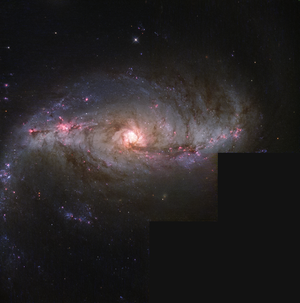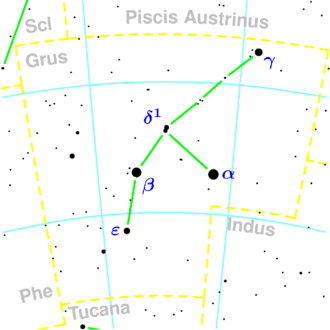NGC 7552
| Galaxy NGC 7552 |
|
|---|---|

|
|
| AladinLite | |
| Constellation | crane |
|
Position equinox : J2000.0 , epoch : J2000.0 |
|
| Right ascension | 23 h 16 m 10.7 s |
| declination | -42 ° 35 ′ 05 ″ |
| Appearance | |
| Morphological type | (R ') SB (s) from / HII / LINER |
| Brightness (visual) | 10.6 mag |
| Brightness (B-band) | 11.4 mag |
| Angular expansion | 3.4 ′ × 2.7 ′ |
| Position angle | 1 ° |
| Surface brightness | 12.9 mag / arcmin² |
| Physical data | |
| Affiliation |
Grus Quartet SSRS Group 40 NGC 7582 Group LGG 472 |
| Redshift | 0.005365 ± 0.000017 |
| Radial velocity | 1608 ± 5 km / s |
|
Stroke distance v rad / H 0 |
(71 ± 5) · 10 6 ly (21.7 ± 1.5) Mpc |
| history | |
| discovery | James Dunlop |
| Discovery date | July 7, 1826 |
| Catalog names | |
| NGC 7552 • IC 5294 • PGC 70884 • ESO 291-12 • MCG -07-47-28 • IRAS 23134-4251 • 2MASX J23161076-4235053 • SGC 231325-4251.4 • VV 440 • GC 4916 • h 3977 • HIPASS J2316-42 • LDCE 1559 NED006 | |
NGC 7552 = IC 5294 is an active bar-spiral galaxy with extensive star formation areas of the Hubble type SBab in the constellation Crane in the southern sky . It is an estimated 71 million light years away from the Milky Way and about 70,000 light years in diameter.
Together with NGC 7582 , NGC 7590 and NGC 7599 , it forms the Grus Quartet.
The Type Ia supernova SN 2017bzc was observed here.
The object was discovered by James Dunlop on July 7, 1826 ( listed as NGC ). Rediscovered by Lewis Swift on October 22, 1897 (listed as IC ).
Web links
Commons : NGC 7552 - collection of images, videos, and audio files
